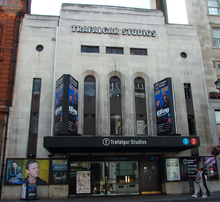Whitehall Theatre
| Whitehall Theatre | |

Trafalgar Studios in 2007
|
|
| Address |
Whitehall London, SW1 United Kingdom |
|---|---|
| Public transit |
|
| Owner | Ambassador Theatre Group |
| Designation | Grade II |
| Type | West End theatre |
| Capacity | Studio 1: 380 seats Studio 2: 100 seats |
| Construction | |
| Opened | 29 September 1930 |
| Rebuilt | 2004 (Tim Foster and John Muir) |
| Architect | Edward A. Stone |
| Website | |
| Trafalgar Studios website (at Ambassador Theatre Group) | |
Coordinates: 51°30′24″N 0°07′39″W / 51.5066°N 0.1275°W
Trafalgar Studios, formerly the Whitehall Theatre until 2004, is a West End theatre in Whitehall, near Trafalgar Square, in the City of Westminster, London.
Also known as Trafalgar Studios at the Whitehall Theatre in honour of its former incarnation, the building consists of two intimate theatres designed by architects Tim Foster and John Muir. Studio 1, the larger of the two spaces with 380 seats, opened on 3 June 2004 with the Royal Shakespeare Company's production of Othello. Studio 2, with 100 seats, opened in October 2005 with the play Cyprus.
The original Whitehall Theatre, built on the site of the 17th century Ye Old Ship Tavern was designed by Edward A. Stone, with interiors in the Art Deco style by Marc-Henri and Laverdet. It had 634 seats. The theatre opened on 29 September 1930 with The Way to Treat a Woman by Walter Hackett, who was the theatre's licensee. In November 1933 Henry Daniell appeared there as Portman in Afterwards. Hackett presented several other plays of his own before leaving in 1934, and the theatre built its reputation for modern comedies throughout the rest of the decade. During World War II it housed revues, which had become commonplace entertainment throughout the West End. In 1942, The Whitehall Follies, featuring Phyllis Dixey, the first stripper to perform in the theatre district, opened with great fanfare and became an immediate success. Dixey leased the theatre and remained in it for the next five years.
...
Wikipedia
